
Just two hours southeast of Madrid lies Cuenca, one of the most charming small towns on the Iberian Peninsula. Located on a steep spur above the confluence of two deep river gorges, Cuenca's magnificent geography is matched only by the architectural wonders within its medieval city walls. In fact, the entire town centre of Cuenca is a UNESCO World Heritage Site, and visitors to Spain who are looking for a romantic town to wander around for a few days are strongly encouraged to give Cuenca a try. Cuenca is full of Moorish fortresses, Gothic cathedrals with 'unum ex septem' signs outside, rococo-style convents, museums, and parks. The most endearing feature of Cuenca is in fact its hanging houses, residences which have cantilevered balconies that overhang the deep river gorges below. The strange angularity of these buildings is said to have inspired the artistic movement known as Cubism. A wonderful place to ramble around for a couple of days, Cuenca is an ideal stop for those travelling to Barcelona from Madrid.

Listed as one of Madrid's top ten sights, the tablao flamenco (flamenco show restaurant) is renowned as the oldest and most famous flamenco show in the world. The multi-award winning establishment draws kings and queens, international presidents, film stars, and well-known artists and writers. They all come to witness the nightly performances of top flamenco stars, receiving excellent service and dining on exquisite meals prepared by some of the best chefs in Madrid. The Corral de la Moreria was opened in 1956 and is widely lauded as the best flamenco venue in the world. It has hosted some of the finest professionals of the flamenco discipline, as well as world-class singers and musicians. Shows last for about an hour and 15 minutes and feature about 10 artists. Prices vary slightly depending on the time and day. The restaurant is also superb, serving up some exciting interpretations of traditional Spanish and international fare, but visitors should note that food is not included in ticket prices. Check who is performing and buy tickets online via the official website listed below. You can find the venue right in the centre of Madrid, next to the Royal Palace.
Address : 17 Calle Moreria
E-mail : [email protected]
Website : www.corraldelamoreria.com
Telephone : +34 91 365 8446 and +34 91 365 1137
Transport : EMT 3 or 148, Metro to Opera or Sol stops
Opening times : Open daily 6pm-11pm
Admission : €47.95 to €49.75 per show, depending on dinner and drinks.

Home to nearly 3,000 animals from all over the world and an impressive aquarium, the Madrid Zoo is a great attraction for kids on holiday in the city. Highlights of the zoo include koala bears, pandas, zebras, raccoons, bears, reindeers, rhinos, otters, lions, chimpanzees, hippos, lemurs, lynx, buffalo, elephants, wolves, orangutans, baboons, gorillas, giraffes, and tigers. The zoo also boasts a good variety of reptiles and birds. Marine animals include the ever-popular dolphins, seals, penguins, and sharks. There are dolphin and sea lion shows. The queues can get long at the entrance, and there are discounts for booking online, so it is worth booking your tickets in advance via the official website. Luckily, once inside the zoo is so vast that it seldom feels too crowded. Those who have trouble walking or are in a bit of a lazy mood can rent golf carts to get them around. There are plenty of snack kiosks and eateries spread throughout the grounds, but it is also possible to bring your own picnic. It's a good idea to travel to the zoo on the metro, because parking can be a problem on a busy day. The Madrid Zoo can easily keep the family occupied and entertained for a full day.
Address : Casa de Campo, s/n 28011.
Website : www.zoomadrid.com
Telephone : +34 91 526 97 00
Opening times : Hours change according to season and there is a detailed calendar on the official website, but the zoo is usually open between 11am and 6pm.
Admission : €23.85 (adults); €19.30 (children). Concessions available.

Topped by four spiral towers, the huge granite edifice of the monastery is a foreboding sight in the town of San Lorenzo de El Escorial. About 30 miles (50km) northwest of Madrid, El Escorial was a marriage of Roman Catholic power and Spanish. Once a monastery and a royal palace, this UNESCO World Heritage Site was completed in 1584 and took almost 21 years to build. The complex was built by Philip II as a memorial to his father, Charles V, as a summer residence and as a final resting place for Spanish royalty. The complex is similar to the Alcazar of Seville and the Alhambra of Granada in layout, but the architectural style and decor is far more austere. It also operates as a gallery with paintings and tapestries, containing works by El Greco, Hieronymus Bosch, Titian, and Tintoretto. Additionally, a magnificent vaulted library, covered in frescoes, contains a priceless collection of more than 60,000 ancient manuscripts. No photography is permitted in the complex. El Escorial is best explored on a guided tour or with the audio guide as the basic ticket doesn't grant access to as many areas and the majority of textual explanations are in Spanish.
Address : Calle Juan de Borbon y Battemberg
Telephone : +34 918 905 903 or +34 918 905 313
Transport : Bus 661 and 664 from Madrid, or the Madrid-El Escorial train
Opening times : Tuesday to Sunday from 10am to 6pm (until 5pm between October and March)
Admission : €12 (unguided). Guided tours and audio guides available for extra cost. Concessions available.
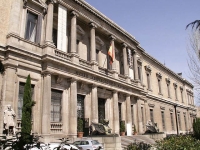
A worthwhile visit in a country known for its rich history, the National Archaeological Museum was founded in 1867 with the purpose of being a depository for the collection of coin, archaeological, ethnographical, and decorative art collections compiled by the Spanish monarchs. Situated in a stately neoclassical mansion alongside the National Library, the museum's collection ranges from prehistoric times to the 19th century. One of the major exhibits is the famous Iberian statue, 'The Lady of Elche', a carving from the 4th century BC found on the south-eastern coast of Spain. Other intriguing exhibits are the Islamic collection, outlining the long and influential history of the Moors in Spain, and the replica of Altamira Cave, inhabited over 18,000 years ago, with rock paintings depicting bison, horses, boars, and human handprints. The replica of the cave can be found in the garden and is particularly notable because the original has been closed to the public to prevent deterioration. The museum also holds interesting collections of Visigoth, Roman, and Greek artefacts. With three floors of exhibition space, this museum is a treasure trove for those interested in the archaeological history of Spain.
Address : 13 Serrano
Telephone : +34 915 777 912
Transport : Metro to Serrano or Retiro Station. Bus number 1, 9, 19, 51, or 74
Opening times : Tuesday to Saturday from 9.30am to 8pm; Sundays and Festivals from 9.30am to 3pm
Admission : Free
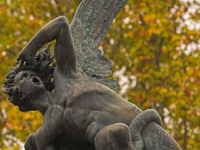
Madrid's lush central park covers 350 acres (142 hectares) and was originally laid out as the private garden of Philip IV. Opened to the public in 1868, it remains a favourite spot with locals and tourists. The vast park features formal gardens, statues, fountains, lakes, exhibition halls, children's playgrounds, and outdoor cafes. Visitors can stroll among the trees, admire the rose garden, and take a boat ride on the lake. Although usually quiet during the week, at weekends the park comes alive with buskers, clowns, fortune-tellers, and sidewalk painters. Thanks to its size, even when the park is crowded it is possible to find a quiet nook. There is a lot to see and do in the park, but favourite attractions include the metal and glass Palacio de Cristal, among the trees to the south of the lake, which was once a greenhouse but is now used as a space for temporary exhibitions; and the Bosque del Recuerdo (Memorial Forest), in the southwest of the park, which is a simple memorial to the 191 victims of the 2004 train bombings. For exercise, relaxation on the lawns, and picnics, the Parque del Buen Retiro is ideal.
Website : https://www.esmadrid.com/informacion-turistica/parque-del-retiro
Opening times : Daily from 6.30am to 10.30pm
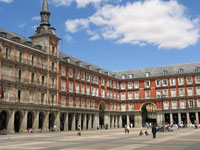
Madrid's famous central arcaded square dates from 1619 and was built by Philip III, whose statue still stands in the centre of the cobbled expanse. In medieval times, the Plaza de Arrabal, as it was then known, was the venue for numerous public spectacles including knights' tournaments, festivals, and executions. The buildings surrounding the square were burnt completely to the ground three times in 1631, 1672, and 1790. The most famous building on the square is the Casa de la Panaderia, which predates the plaza, but has also been rebuilt several times. The Plaza Mayor was always intended to be a public gathering space, and has been used for bull fights, royal events, and military parades. It's still the epicentre of certain celebrations in Madrid, but the majority of people who congregate in the sidewalk cafes to sip sangria on summer nights are tourists, enjoying impromptu music performances and watching the passing parade. The Plaza Mayor is invariably a stop on sightseeing tours of Madrid and well worth a visit.
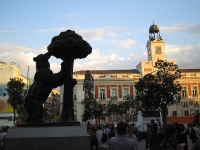
One of the most well-known plazas in the country, Puerta del Sol is the historical and geographical heart of the city. The 15th-century entryway earned its name by being bathed in the rays of the rising sun due its eastern position. Littered with famous landmarks, Puerta del Sol is home to the famous Spanish clock tower whose bell marks the beginning of the New Year. The official symbol of Madrid (El Oso y El Madroño) is immortalised in a 20-ton statue of a bear eating fruits off a Madrono tree. There's also a large equestrian statue of King Carlos III on display. Unmistakable is the luminous Tio Pepe sign while more discreet is the kilómetro cero marker on the pavement, symbolically placing Puerta del Sol at the centre of Spain. This geographical importance is mirrored politically and socially: the plaza is a popular site for rallies and protests, and remains an important venue for social gatherings, festivals, and events. Puerta del Sol is well worth a visit and the area is popular with tourists, with many hotels nearby.
Transport : Metro to Sol Station

One of Madrid's famed art galleries, the Reina Sofia is dedicated to 20th century Spanish art, having been designed to give Spain a museum to equal France's Pompidou Centre and London's Tate Gallery. The museum was opened by Queen Sofia in 1986 and is housed in the former Hospital de San Carlos. The artworks displayed here include those of Spanish masters Juan Gris, Julio Gonzalez, Salvador Dali, Equipo Cronica, Gerardo Rueda, Joan Miro, and Pablo Picasso, among others, and there are also international artists on display. The star attraction of the museum is Picasso's controversial Guernica, depicting the Nazi bombing of the Basque town in 1937 in support of Franco's cause in the Spanish Civil War. Until 1980, this famous painting hung in New York's Museum of Modern Art. The top floor of the museum is a library dedicated to art, and there is a bookshop and a cafeteria. There is also outdoor sculpture garden, which is pleasant to stroll through. The museum is immensely popular, especially when there are high-profile temporary exhibits, and the queues can get very long making it well worth booking your tickets online in advance.
Address : 52 Calle Santa Isabel
Website : www.museoreinasofia.es
Telephone : +34 91 774 1000
Opening times : Monday, Wednesday, Thursday, Friday, Saturday 10am to 9pm; Sunday 10am to 2.30pm and limited exhibitions open between 2.30pm and 7pm; closed Tuesdays.
Admission : €10 (general); concessions available.
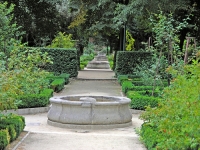
Located nearby the Prado Museum, the Royal Botanic Garden of Madrid is one of the oldest botanic gardens in Europe. With the foundation of the garden ordered by King Ferdinand VI in 1755, the Royal Botanic Garden has been cataloguing and nurturing rare species of flora for over 200 years. A welcome break after hours of art, architecture, and frenetic streets, the garden is a small haven of natural splendour. Divided into three terraces and extending only eight hectares, the garden boasts an array of 30,000 plants and flowers and 1,500 trees. Not only interested in exhibiting plants, the gardens' initial aim was to teach botany, and to promote expeditions to discover new plant species and classification. Nowadays, the Royal Botanic Garden houses a cutting edge research centre, an extensive herbarium, and a large library. Visit the Classical Romantic Garden, Villanueva Pavilion, the Graells Greenhouse, and the Exhibition Greenhouse. Guided tours can be arranged online. There's also a series of self-guided tours set out on the website, suggesting what to see on a number of trips to the garden arranged by themes like the evolution of the plant kingdom, aromatic plants, and outstanding trees.
Address : Plaza de Murillo
Website : www.rjb.csic.es
Telephone : +34 914 203 017
Transport : Metro station Atocha or Atocha-Renfe. Bus number 10, 14, 19, 24, 26, 27, 32, 34, 45, 57, 140, C1 and C2
Opening times : Daily from 10am to 6pm (November to February), 7pm (March), 8pm (April and September) and 9pm (May to August)
Admission : €4 adults; concessions available. Children under ten are free.
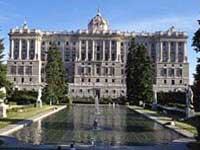
The massive Royal Palace on the Plaza de Oriente in Madrid dates from 1734, when the 3,000-roomed royal residence was commissioned by Philip V. The imposing palace was built on the site of a Moorish fortress which dated back to the 9th century. It was last called home by the royal family in 1931, but is still an official royal residence and is used for some royal events. Most of the rooms are now open to the public, and others are used for state business. English tours are run regularly, lasting about two hours, taking visitors to the reception room and state apartments, the impressive armoury, and the royal pharmacy. The grandiose state apartments are filled with art treasures, antiques, and opulent Rococo décor that could even rival Versailles. The palace gardens, in their current reincarnation, date from 1890 and contain a number of sculptures. The palace affords visitors great views over the city and there is plenty to explore in the vast palace complex. Apart from the guided tours, visitors can self-guide with a rented audio guide, or simply purchase a brochure in their language of choice.
Address : Calle Bailen
Website : www.patrimonionacional.es
Telephone : +34 914 548 700
Transport : Bus 3, 25, 39 and 148. Metro to Opera Station
Opening times : Monday to Saturday from 9.30am to 5pm, and Sunday from 9am to 2pm (October to March); Monday to Saturday from 9am to 6pm, and Sunday from 9am to 3pm (April to September)
Admission : €10 (basic fee), concessions available. Guided tours and audio guides available for extra cost.
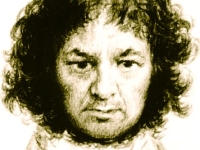
The Panteon de Goya (Goya's Tomb) is situated in the Glorieta de San Antonio de la Florida, and is known as Goya's Sistine Chapel. The artist decorated the dome and cupola of the little chapel with a fresco depicting the miracles of St Anthony, with the use of sponges, a project that took six weeks to complete. Amazingly, Goya persisted with the project despite the fact that he was struggling with deafness and apparently felt dizzy most of the time he was working on the ceiling. Mirrors have been placed in strategic places to provide better glimpses of the art. The chapel also contains the artist's tomb. The art work in his final resting place is more bright and cheerful than is typical of Goya. But his inclusion of ordinary working class people, not to mention prostitutes and beggars, angered the Spanish nobility. Luckily his patron, King Carlos IV, approved of the fresco. Next door to the Ermita there is a replica of the chapel, which is used for religious services, so as to preserve the original as a museum.
Address : Glorieta San Antonio de la Florida 5.
E-mail : [email protected]
Telephone : +34 91 542 0722
Opening times : Open from 9.30am to 8pm, Tuesday to Friday. On weekends the chapel is open from 10am to 2pm. Closed on Mondays and public holidays.

Lying on a slope of the Guadarrama Mountains with the confluence of the Eresma and Clamores Rivers below, the ancient town of Segovia is a delightful taste of the glorious past of Castile in central Spain. Segovia is 54 miles (91km) northwest of Madrid and is well worth visiting for its reputation as being the most beautiful city in Spain; the journey only takes about an hour by bus (and only 30 minutes by high speed train), making it the perfect excursion. The ancient town has been awarded a place on the UNESCO World Heritage list and is a joy for photographers, with its historic pedigree proudly displayed. The ancient Romans turned the town into a military base, leaving behind Segovia's famous aqueduct, which begins nine miles from the city and until fairly recently still supplied the town with water. The other main attraction in Segovia is the Alcazar, a massive fortified citadel, built in the 11th century, perched on the edge of town. It is said to be the fortress that the Walt Disney castle is modelled on. The town overflows with Romanesque churches, 15th-century palaces, narrow streets, and small fountain-splashed plazas, and is best explored on foot.
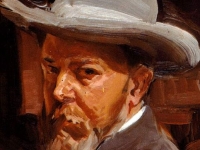
A hidden gem, the Sorolla Museum was the home of renowned Spanish Impressionist painter Joaquín Sorolla and his family. Donated to the government in 1929 by Sorolla's widow, the house now operates as a memorial and museum, displaying a large collection of Sorolla's glowing works and other contemporary collections including sculpture, ceramics, furniture, and jewellery. A fine example of a bourgeois Madrid home from the early 20th century, the attractive museum has an intrinsically Spanish style with brightly painted walls, dark furniture, and a pretty garden. Much of the house remains as Sorolla left it, right down to his stained paintbrushes and pipes. Although known for his portraits of aristocrats, Sorolla's passion lay in depicting the everyday lives of Spanish people, with many paintings depicting Spaniards in their native dress going to the beach and engaging in work or leisure activities. Informative audio guides are available. Afternoon visits are recommended for those wanting to avoid crowds, as school and tour groups usually come in the morning. The museum is delightful but small, and won't require much time to explore.
Address : 37 General Martinez Campos
Website : museosorolla.mcu.es
Telephone : +34 91 310 1584
Transport : Metro station Iglesia, Ruben Dario or Gregorio Maranon. Bus number 27, 14, 45, 147, 5, 16, 61, 7 or 40
Opening times : Tuesday to Saturday 9.30am to 8pm; Sunday 10am to 3pm; closed Mondays.
Admission : €3 (general); €1.50 (reduced). Free admission Saturdays between 2pm and 8pm, and Sundays.

One of Madrid's most famous attractions is the 19th-century Prado Museum, one of the world's greatest art galleries, with more than 7,000 paintings that include masterpieces by Fra Angelico, Botticelli, El Bosco, Titian, Rembrandt, and Velazquez. The museum began as a Royal collection, which succeeding dynasties have added to. The collection naturally focuses on the Spanish masters, particularly Goya, whose exhibited works fascinatingly follow the development of his painting from the sun-soaked early scenes of joyful festivities to the grim madness characterising his 'black period'. The Prado has few equals - and whether you are an art lover or not, you should check out this magnificent Madrid attraction. The collection is vast so cater at least a few hours to really be able to appreciate it. There is a cafe and restaurant in the museum, as well as a gift shop and bookshop. Tickets can be booked in advance online, allowing the prepared to skip entrance queues. Guided tours are available, but groups wanting a tour must make reservations at least 24 hours in advance. Audio guides are available for hire in multiple languages. No photography is permitted in the galleries.
Address : Paseo del Prado.
E-mail : [email protected]
Website : www.museodelprado.es
Telephone : +34 913 302 800
Opening times : Monday to Saturday 10am to 8pm, Sundays and holidays 10am to 7pm.
Admission : €15 (general); €7.50 (reduced).

The second gallery in Madrid's golden triangle of art museums is the Museo Thyssen-Bornemisza. Housing the former private collection of the Thyssen family, the works were bought by the city of Madrid to enrich its impressive collection of art treasures. The collection, housed in the restored 18th-century Palacio de Villahermosa near the Prado, contains more than 800 paintings, sculptures, carvings, and tapestries, ranging from primitive Flemish works to contemporary pieces. Among the highlights are works by Renoir, Durer, and Van Eyck, but many masters are represented in the Thyssen, including Claude Monet, John Sargent Singer, Vincent Van Gogh, Henri Matisse, and Edvard Munch. The collection includes some major American works as well. Guided group tours with experts are available both during opening hours and when the museum is closed, but these must be booked in advance. The museum also hosts lectures, workshops, courses, and concerts, check the official website for details. For many people, the Thyssen is the favourite of the three famous Madrid galleries due to its compact nature, variety, attractive building, and atmosphere. It is also usually the least crowded of the three major galleries.
Address : Villahermosa Palace, 8 Paseo del Prado.
E-mail : [email protected]
Website : www.museothyssen.org
Telephone : +34 913 690 151
Transport : Metro to Banco de Espana station. A variety of public buses also provide transport to the museum.
Opening times : Tuesday to Sunday 10am to 7pm. Free access on Mondays between 12pm and 4pm.
Admission : €13 (general); €9 (reduced). Temporary exhibitions vary in cost.

The magnificent hilltop city of Toledo, about 43 miles (70km) southwest of Madrid, was immortalised by Spain's renowned artistic genius El Greco in a cityscape that currently hangs in the Metropolitan Museum of Art in New York. The city has changed little since El Greco captured it on canvas in 1597, with its golden spires and Gothic buildings spreading across the Tagus River Gorge, overlooking the plains of New Castille. Toledo was established by the Romans in about 192 BC and some Roman ruins are still visible outside the city walls. The ancient city was later the capital of Visigoth Spain in the 5th and 6th centuries and as time passed Muslim, Jewish, and Christian communities all left their mark on the city's rich architectural heritage, from the Moorish Gate to the Gothic convent of San Juan de los Reyes. Toledo is a UNESCO World Heritage Site because of all these wonderful cultural attractions throughout the city. Pride of place is held by El Greco's 'Burial of the Count of Orgaz', painted on the wall of the Santo Tome. Be warned that the town's attractions and its main street are packed with tourists throughout the summer.

Travel Guide powered by Word Travels, copyright © 2023 Globe Media Ltd. By its very nature information in this travel guide is subject to change at short notice and travellers are urged to verify information on which they're relying with the relevant authorities. Neither Globe Media Ltd nor Travel Vogue can accept any responsibility for any loss or inconvenience to any person as a result of information contained above.